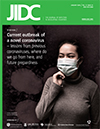Commensal and virulent Escherichia coli strains of vaginal origin are reservoirs of resistance cassettes in class 1 integrons
DOI:
https://doi.org/10.3855/jidc.11940Keywords:
Escherichia coli, Class 1 integrons, antimicrobial resistanceAbstract
Introduction: Antimicrobial resistance in Escherichia coli, one of the causal agents of aerobic vaginitis, leads to the persistence of the infection. The investigation of integrons acquires relevance, since they are elements that are responsible for the acquisition of resistance to antibiotics. The aim of this work was to describe the structural diversity of class 1 integrons in virulent and commensal strains of E. coli isolated from patients with vaginal infection.
Methodology: Ninety-two strains of E. coli were isolated from patients with aerobic vaginitis. Resistance profile against 19 antibiotics and class 1 integrons were detected by PCR. The identity and arrangement of cassettes was determined by sequencing. ERIC-PCR assays were carried out in strains with identical arrays. Finally, genotyping by Clermont algorithm and serotyping were performed. Seventeen strains showed integrons located in plasmids.
Results: Ten different gene cassette arrays were identified in 30 strains of E. coli. Cassettes corresponding to genes coding for adenylyltransferases (aadA), dihydrofolate reductases (dfrA), and oxacillinases (blaOXA) were detected. Array dfrA17-aadA5 was predominantly prevalent over the other arrays identified. Phylogenetic group A was the most predominant, followed by group B2 and D.
Conclusions: This study demonstrates the presence of E. coli of vaginal origin carrying class 1 integrons, which are main genetic elements of capture of resistance genes, with the possibility of capturing new resistance cassettes. These evidences should serve for the modification of protocols in the diagnosis and treatment of aerobic vaginitis, and the development of policies for the rational use of antimicrobials.
Downloads
Published
How to Cite
Issue
Section
License
Authors who publish with this journal agree to the following terms:
- Authors retain copyright and grant the journal right of first publication with the work simultaneously licensed under a Creative Commons Attribution License that allows others to share the work with an acknowledgement of the work's authorship and initial publication in this journal.
- Authors are able to enter into separate, additional contractual arrangements for the non-exclusive distribution of the journal's published version of the work (e.g., post it to an institutional repository or publish it in a book), with an acknowledgement of its initial publication in this journal.
- Authors are permitted and encouraged to post their work online (e.g., in institutional repositories or on their website) prior to and during the submission process, as it can lead to productive exchanges, as well as earlier and greater citation of published work (See The Effect of Open Access).








